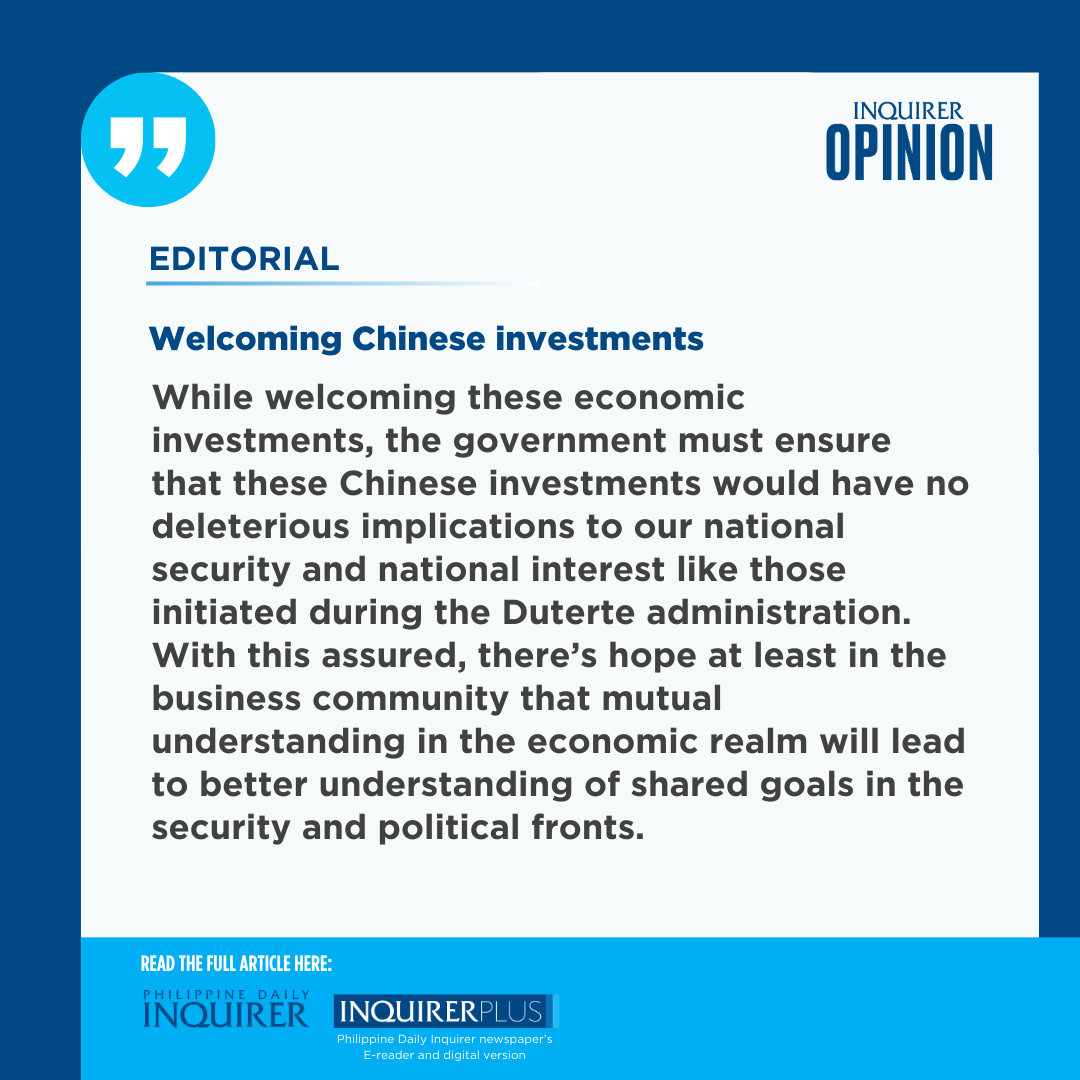Welcoming Chinese investments
Secretary Frederick Go, the special assistant to the President for investment and economic affairs, announced last week that Panhua Integrated Steel Inc. of China is investing $1 billion or P55.98 billion in a steel manufacturing plant that will rise in the town of Maasim in Sarangani province.
According to Go, the Panhua plant at the Kamanga Agro-Industrial Economic Zone is the single biggest foreign direct investment (FDI) so far under the Marcos administration, which has been pulling out all the stops to entice more job-generating investments in the country.
Article continues after this advertisement“Through good governance and the improved peace and order condition, the economy of Mindanao has been growing stronger and stronger,” said Go, who spoke at the 33rd Mindanao Business Conference last week.
That this large investment came from a unit of Panhua Group Co. Ltd., one of the largest companies in China, was especially welcome and symbolic, with President Marcos seeing it as a clear signal that despite increasingly dangerous Chinese incursions in the West Philippine Sea, trade and investment relations between the two nations continue to flourish.
Poorest provinces
Back in 2019, Panhua pledged to plunk in as much as $3.5 billion at the Phividec Industrial Estate in Misamis Oriental where it planned to set up an integrated steel mill that can produce 10 million tons of steel a year.
Article continues after this advertisementThe group has since decided to relocate to Sarangani with the production capacity likewise slashed to an estimated two million metric tons a year. The plant is expected to start production in December 2025, and generate some 2,000 jobs, including 500 for engineers.
What is more important is the message that Chinese companies continue to see merit in investing in the Philippines, particularly in Mindanao where most of the poorest provinces in the country are located.
Go said during the conference that from 2022 to 2024, approved FDIs across Mindanao reached P198.6 billion, mainly in the mining, power, and manufacturing, particularly steel, which the President is particularly keen on developing given that the Philippines is the only member-state of the Association of Southeast Asian Nations without its own integrated steel mill.
Quality steel products
Indeed, in crude steel terms, the Philippines imports as much as 80 percent of its steel requirements. Thus his administration has embarked on a mission that by 2030, there will be a flourishing local iron and steel industry that will produce most of the quality steel products that it needs for its own use, and it will need the help of investors—including those from China—to make that vision happen.
But as the Philippines rolls out the red carpet for these badly needed investments, regulators and government agencies must also make sure that it welcomes only those that align with our own commercial and national interests.
The Philippines must ensure that these investors will faithfully and rigorously comply with local laws, from acceptance by the local community to compliance with local labor and environment laws, which particularly apply to heavy industries such as steel.
Indeed, the Philippines must look at these investments with eyes wide open, but also with the openness to the possibility of working together despite geopolitical tensions.
This has been expressed, for instance, not just by the investment in the steel plant but more recently in the P4.6 billion in investment pledges from Chinese firms during an investment mission in Xiamen from Sept. 4.-10.
Peza zones
Tereso Panga, director general of the Philippine Economic Zone Authority, said that these would go into expansions of existing Chinese registered business enterprises in Peza zones.
The biggest among these came from industrial bearings manufacturer C&U, which will invest P2.72 billion in the construction of a new building and production line. Huading Industries Corp., on the other hand, which manufacturers quartz slabs, plans to invest P1 billion to expand its facility in Tanza, Cavite, by another 1.3 hectares.
From January to August 2024, Peza has approved a total of P2.02 billion from the combined investments of mainland China and Hong Kong, more than three times higher the P769 million approved in the same period last year.
Panga, who attended the 24th China International Fair for Investment and Trade, said the mission “reinforce Chinese investors’ serious interest to further invest in the Philippines.”
While welcoming these economic investments, the government must ensure that these Chinese investments would have no deleterious implications to our national security and national interest like those initiated during the Duterte administration.
With this assured, there’s hope at least in the business community that mutual understanding in the economic realm will lead to better understanding of shared goals in the security and political fronts.

















